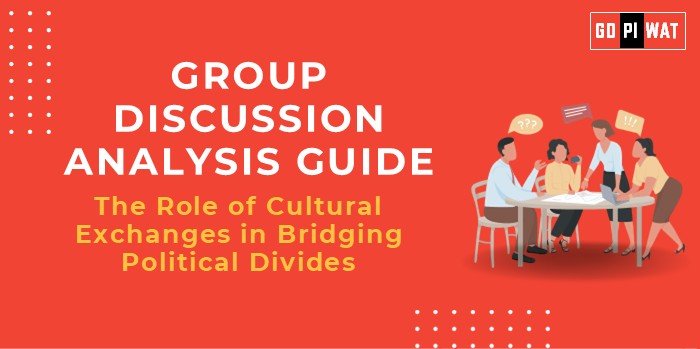📋 Group Discussion (GD) Analysis Guide
🌏 The Role of Cultural Exchanges in Reducing Tensions Between Nations
💡 Introduction to the Topic
🌱 Opening Context: Cultural exchanges have historically played a critical role in bridging divides and fostering mutual understanding. In a world increasingly divided by political ideologies, they hold immense potential for easing tensions between nations with conflicting political systems.
📜 Topic Background: From Cold War-era sports diplomacy to modern art and education exchanges, cultural interactions have often transcended political boundaries. Recent examples include collaborations like the US-China cultural exchanges despite strategic competition, demonstrating their role in maintaining dialogue.
📊 Quick Facts and Key Statistics
- 🎓 International Student Mobility (2022): Over 5 million students study abroad annually, promoting cross-cultural understanding.
- 📈 UNESCO Data (2023): Cultural exchange programs saw a 30% increase post-COVID-19, signaling renewed global collaboration.
- 🗣️ Public Sentiment: Surveys indicate that 65% of people view cultural diplomacy as more effective than political dialogue for reducing tensions.
🌍 Stakeholders and Their Roles
- 🏛️ Governments: Establish and fund cultural exchange initiatives, fostering public diplomacy.
- 🌐 International Organizations: UNESCO and others facilitate global cultural collaboration.
- 🎓 Educational Institutions: Act as key hubs for student and faculty exchanges.
- 💼 Private Sector: Sponsors exchange programs and cultural events.
- 🤝 Civil Society: Drives grassroots cultural diplomacy through art, language, and local collaborations.
🏆 Achievements and Challenges
🌟 Achievements:
- ✔️ Global Collaboration: Programs like Fulbright have trained leaders who advocate global peace.
- 🎶 Soft Power Enhancement: Nations like South Korea have used cultural exports (e.g., K-pop) to improve their global image.
- 🤝 Conflict Reduction: Initiatives such as ping-pong diplomacy softened Cold War hostilities.
⚠️ Challenges:
- 🚧 Political Barriers: Authoritarian regimes often limit cultural exchanges.
- 💰 Economic Inequalities: Developing nations face funding challenges in supporting these programs.
- 🤔 Misinformation: Stereotypes and biases may persist despite cultural exchanges.
🌍 Global Comparisons:
- ✅ Success: Germany’s Goethe-Institut excels in fostering cross-cultural understanding.
- ❌ Challenges: Cultural exchanges between India and Pakistan face political and security barriers.
📜 Case Studies:
- 🌟 US-China Fulbright Program: Continued during periods of strained relations, fostering dialogue.
- 🎭 France’s Alliance Française: Promotes French culture globally while respecting local nuances.
✨ Structured Arguments for Discussion
- 💬 Supporting Stance: “Cultural exchanges break down barriers, as seen in the enduring US-Russia scientific collaborations despite Cold War tensions.”
- ⚖️ Opposing Stance: “Without addressing political distrust, cultural exchanges may have limited impact, as observed in strained North Korea-South Korea relations.”
- 🔄 Balanced Perspective: “While cultural exchanges build soft power and mutual respect, their success depends on addressing deeper political hostilities.”
🎯 Effective Discussion Approaches
📖 Opening Approaches:
- 📊 Highlight statistics on the success of cultural diplomacy initiatives globally.
- 📜 Use an impactful case study, such as the Olympic truce.
🔄 Counter-Argument Handling:
- ✔️ Recognize political limitations and propose solutions like neutral platforms.
- 💡 Emphasize the long-term benefits of cultural engagement over short-term political hurdles.
📈 Strategic Analysis of Strengths and Weaknesses
- 💪 Strengths: Promote empathy, build global partnerships.
- ⚠️ Weaknesses: Limited scope under restrictive regimes.
- 💡 Opportunities: Leveraging digital platforms for wider reach.
- 🚨 Threats: Geopolitical tensions hindering collaboration.
📚 Connecting with B-School Applications
- 🌟 Real-World Applications: Applicable to international business, global marketing, and strategic leadership.
- 💬 Sample Questions:
- “How can cultural exchanges strengthen global trade partnerships?”
- “Discuss an example where cultural diplomacy resolved a conflict.”
- 📖 Insights for Students:
- Cultural understanding enhances global networking.
- Strengthens leadership in multicultural teams.


